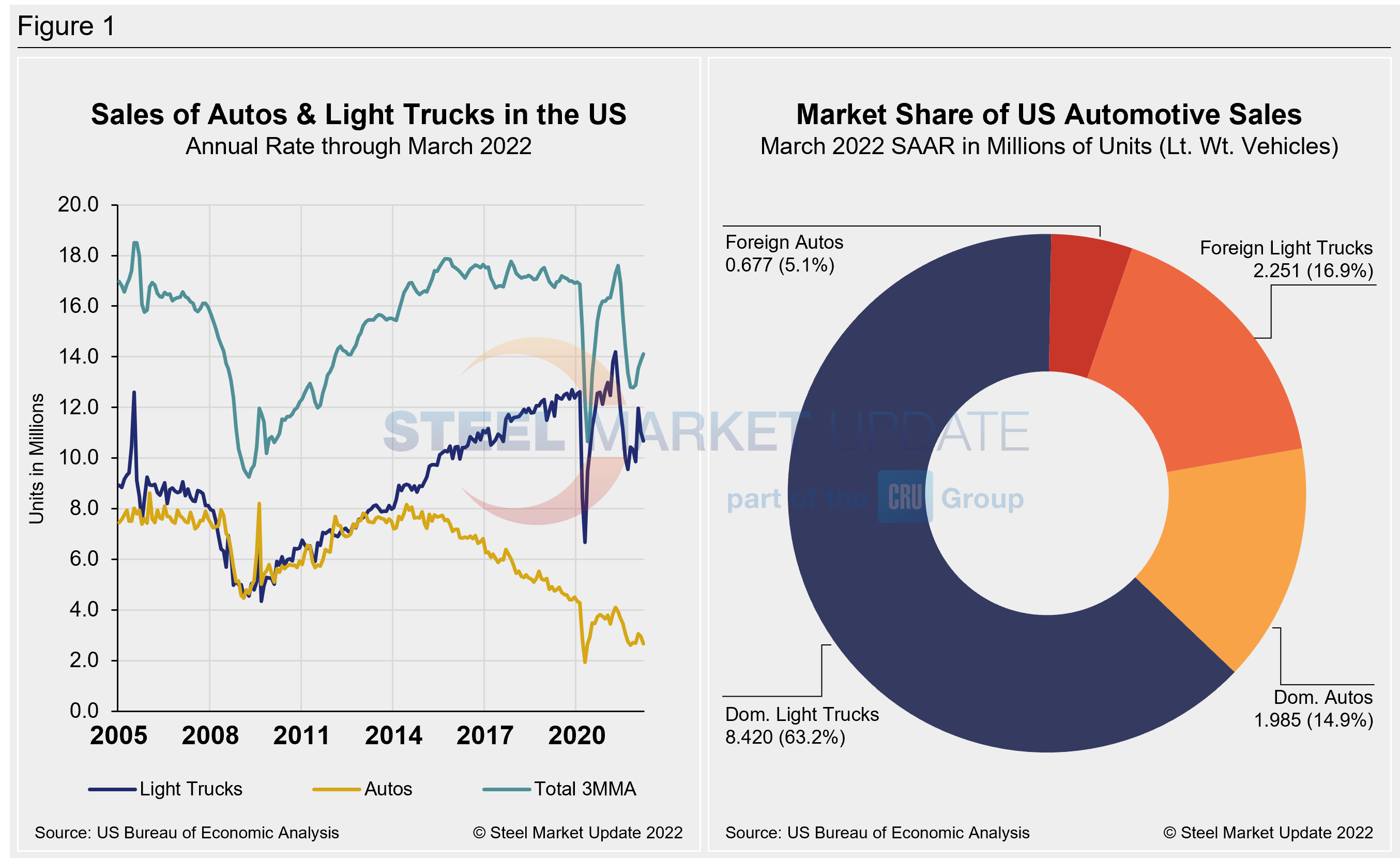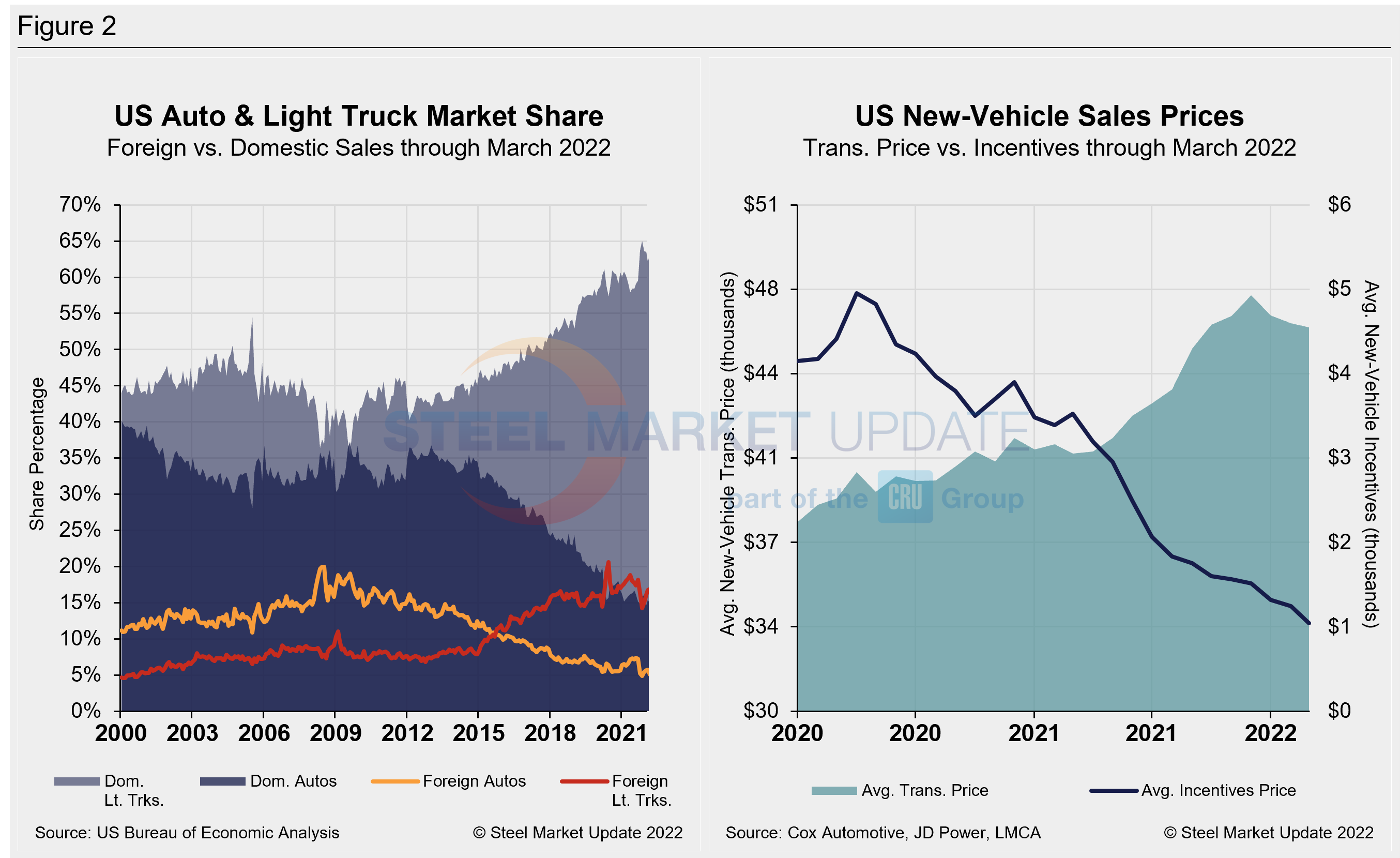Steel Markets

US Light Vehicle Sales Fall in March
Written by David Schollaert
April 15, 2022
US light vehicle sales fell to 1.26 million units in March, down 22% year on year. The annualized selling rate declined to 13.332 million units from 14.071 million units the month prior, the US Bureau of Economic Analysis (BEA) reported.
Interest rates are rising. But that’s probably not what’s holding sales back. It is supply rather than demand that is driving sales and disrupting normal seasonality. The decline in domestic sales last month was driven by extremely tight inventories. Fleet sales, however, were a bright spot though, showing signs of recovery in March and accounting for 14.9% of the total market.
The global light-vehicle selling rate fell to 75 million units per year in March, bringing the Q1 2022 average to 79 million units annually. Global supply‐chain issues continued to constrain sales, bringing sales down 14% year on year, according to LMC Automotive.
Below in Figure 1 is the long-term picture of sales of autos and lightweight trucks in the US from 2005 through March 2022, as well as the market share sales breakdown of last month’s 13.332 million vehicles at a seasonally adjusted annual rate.

Microchip and parts shortages continue to impact automotive production, resulting in tight inventories and high transaction prices. This dynamic is leading carmakers to focus on high-demand vehicles. A run-up in the average transaction price (ATP) coincides with historically low incentives.
New-vehicle ATPs decreased to $45,927 in March, falling for the third straight month after reaching a record high of $47,243 in December 2021. Though prices fell 0.3% (-$156) last month versus February, they remain 12.9% (+$5,247) above the year-ago period, according to Cox Automotive data.
Incentives dropped to a record low of $1,044 on average in March, roughly 2.3% of the average transaction price. Incentives are down 70.4%, or $2,483, year on year.
In March, the annualized selling rate of light trucks was 10.670 million units, down 3.2% versus the prior month and down 22.7% year on year. Auto annualized selling rates were even lower during the same periods: down 9.7% and down 30.8%, respectively.
Figure 2 details US auto and light-truck market share since 2010 and the divergence between average transaction prices and incentives in the US market since 2020.

New vehicle inventory days’ supply was in the low 30s in March while customer demand remained high. These conditions enabled dealers to continue selling inventory at or above the manufacturer’s suggested retail price (MSRP), in some cases as high as 7.8% to 9.8% over MSRP in March.
Still, available supply was down 59% from the same period in 2021. In raw numbers, the supply of unsold new vehicles as March opened was about 1.5 million vehicles less than the stock of a year ago and 2.4 million less than in 2020.
From February 2020 – the month before the widespread Covid-related shutdowns – through March 2022, the new vehicle APT in the US is up 21%, while average new-vehicle incentives prices are down 78%. All told, buyers are paying on average $11,181, or 33%, more for new vehicles than they did before the pandemic.
Canada and Mexico saw similar dynamics last month. In Canada, light-vehicle sales declined by 18.9% year on year in March to 142,000 units. The selling rate decelerated to 1.52 million units annually last month, from 1.67 million units per year in February. March 2021 was the strongest month of last year, whereas the ongoing lack of supply continues to handicap the market in 2022.
Mexican auto sales were down by 0.3% year over year in March, at 95,000 units, while the selling rate accelerated to 1.11 million units per year, from 1.06 million units per year in February. This was the smallest year-over-year decline since August 2021, when the market was in growth territory.
Editor’s Note: This report is based on data from the US Bureau of Economic Analysis (BEA), LMC Automotive, JD Power, and Cox Automotive for automotive sales in the US, Canada, and Mexico. In specific, the report describes light vehicle sales in the US.
By David Schollaert, David@SteelMarketUpdate.com

David Schollaert
Read more from David SchollaertLatest in Steel Markets

USW cheers Evraz NA agreement with Atlas Holdings
The United Steelworkers (USW) labor union celebrated recent news of the signed agreement between Atlas Holdings and Evraz NA in which the Connecticut-based private equity company said it plans to acquire North America’s Evraz facilities.

Steel buyer spirits tempered by soft spot market conditions
Steel sheet buyers report feeling bogged down by the ongoing stresses of stagnant demand, news fatigue, tariff negotiations or implementation timelines, and persistent macroeconomic uncertainty.

Hot-rolled coil buyers continue seeking certainty
Steel market participants contend that buyers will remain in “wait-and-see" mode until some market stability is restored.

Latin American steel advocates warn on cheap import flood
Subsidized Chinese steel imports and cheap steel products from Association of Southeast Asian Nations (ASEAN) entering Latin American (LATAM) are threatening the region's steel market.

CRU: Steel prices fall amid global demand weakness
The forceful headwinds bearing down on steel markets across the globe have created demand challenges and sent prices southward. The US, however, challenged the global trend.
